Kiss of Judas
The kiss of Judas, also known (especially in art) as the Betrayal of Christ, is the act with which Judas identified Jesus to the multitude with swords and clubs who had come from the chief priests and elders of the people to arrest him, according to the Synoptic Gospels. The kiss is given by Judas in the Garden of Gethsemane after the Last Supper and leads directly to the arrest of Jesus by the police force of the Sanhedrin.
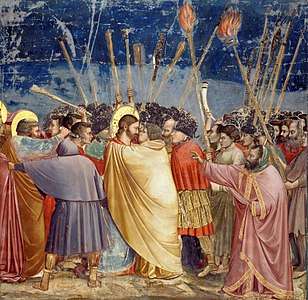
Within the life of Jesus in the New Testament, the events of his identification to hostile forces and subsequent execution are directly foreshadowed both when Jesus predicts his betrayal and Jesus predicts his death.
More broadly, a Judas kiss may refer to "an act appearing to be an act of friendship, which is in fact harmful to the recipient".[1]
In the New Testament
The gospels of Matthew (26:47–50) and Mark (14:43–45) both use the Greek verb καταφιλέω (kataphileó), which means to "kiss, caress; distinct from φιλεῖν (philein); especially of an amorous kiss"[2] It is the same verb that Plutarch uses to describe a famous kiss that Alexander the Great gave Bagoas.[3] The compound verb (κατα-) "has the force of an emphatic, ostentatious salute".[4] Lutheran theologian Johann Bengel suggests that Judas kissed Him repeatedly: "he kissed Him more than once in opposition to what he had said in the preceding verse: Greek: φιλήσω, philēsō, a single kiss (Matthew 26:48), and did so as if from kindly feeling".[5]
According to Matthew 26:50, Jesus responded by saying: "Friend, do what you are here to do". Luke 22:48 quotes Jesus saying "Judas, are you betraying the Son of Man with a kiss?"[6]
Jesus' arrest follows immediately.[7]
In liturgics
In the Divine Liturgy of Saint John Chrysostom the Greek Orthodox Church uses the troparion Of thy Mystical Supper.., in which the hymnist vows to Jesus that he will "...not kiss Thee as did Judas..." («...οὐ φίλημά σοι δώσω,καθάπερ ὁ Ἰούδας...»):
In art
The scene is nearly always included, either as the Kiss itself, or the moment after, the Arrest of Jesus, or the two combined (as above), in the cycles of the Life of Christ in art or Passion of Jesus in various media. In some Byzantine cycles it is the only scene before the Crucifixion.[9] A few examples include:
- Probably the best known is from Giotto's cycle in the Scrovegni Chapel in Padua.
- The Taking of Christ by Caravaggio.[10]
- A sixth-century Byzantine Mosaic in Ravenna.
- A fresco by Barna da Siena.
- A sculpture representing the Kiss of Judas appears on the Passion façade of the Sagrada Família basilica in Barcelona.
- The kiss of Judas in art
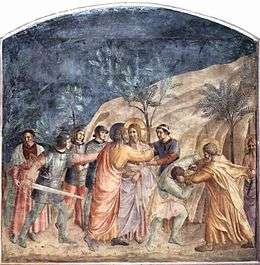 Fresco by Fra Angelico, San Marco, Florence, 1437–1446
Fresco by Fra Angelico, San Marco, Florence, 1437–1446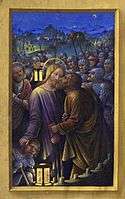 Judas betraying Jesus with a kiss, in the Grandes Heures of Anne of Brittany, between 1503 and 1508
Judas betraying Jesus with a kiss, in the Grandes Heures of Anne of Brittany, between 1503 and 1508.jpg) The Taking of Christ by Caravaggio, 1602.
The Taking of Christ by Caravaggio, 1602.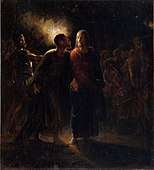 Wilhelm Marstrand, Kiss of Judas, undated (between 1830 and 1873),
Wilhelm Marstrand, Kiss of Judas, undated (between 1830 and 1873),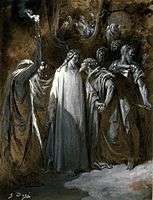 Study for The Judas Kiss by Gustave Doré, 1865
Study for The Judas Kiss by Gustave Doré, 1865_-_James_Tissot.jpg) The Kiss of Judas by James Tissot, Brooklyn Museum, between 1886 and 1894
The Kiss of Judas by James Tissot, Brooklyn Museum, between 1886 and 1894
See also
| Events in the |
| Life of Jesus according to the canonical gospels |
|---|
 |
|
In rest of the NT |
|
Portals: |
References
- "Judas kiss". TheFreeDictionary.com.
- καταφιλέω. Liddell, Henry George; Scott, Robert; A Greek–English Lexicon at the Perseus Project
- Plutarch (1919). "67.4". Alexander. Translated by Bernadotte Perrin.
λέγεται δὲ μεθύοντα αὐτὸν θεωρεῖν ἀγῶνας χορῶν, τὸν δὲ ἐρώμενον Βαγώαν χορεύοντα νικῆσαι καὶ κεκοσμημένον διὰ τοῦ θεάτρου παρελθόντα καθίσαι παρ᾽ αὐτόν: ἰδόντας δὲ τοὺς Μακεδόνας κροτεῖν καὶ βοᾶν φιλῆσαι κελεύοντας, ἄχρι οὗ περιβαλὼν κατεφίλησεν
- Vincent's Word Studies on Matthew 26, accessed 27 February 2017
- Bengel's Gnomon on Matthew 26, accessed 27 February 2017
- Dear, John. "On Holy Thursday, betrayal and friendship", National Catholic Reporter, March 27, 2012
- Matthew 26:50
- Rev. Nicholas M. Elias (2000) [1966]. The Divine Liturgy Explained (4 ed.). Athens: Papadimitriou Publishing Co.
- Schiller, Gertrud, Iconography of Christian Art, Vol. II, p. 52, 1972 (English trans from German), Lund Humphries, London, ISBN 0853313245
- For a discussion of the kiss of Judas with respect to Caravaggio's The Taking of Christ (now in the National Gallery of Ireland, Dublin), together with a summary of traditional ecclesiastical interpretation of that gesture, see Franco Mormando, "Just as your lips approach the lips of your brothers: Judas Iscariot and the Kiss of Betrayal" in Saints and Sinners: Caravaggio and the Baroque Image, ed. F. Mormando, Chestnut Hill, MA: The McMullen Museum of Art of Boston College, 1999, 179–90.
Further reading
- Grubb, Nancy (1996). The Life of Christ. New York City: Abbeville Publishing Group. ISBN 0-7892-0144-5. OCLC 34412342.
